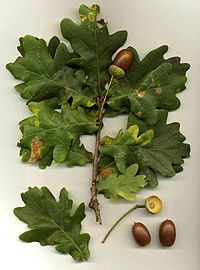
Photo from wikipedia
American chestnut (Castanea dentata) was a dominant species in eastern North America prior to the importation of chestnut blight. In light of recent efforts to restore viable populations of chestnut… Click to show full abstract
American chestnut (Castanea dentata) was a dominant species in eastern North America prior to the importation of chestnut blight. In light of recent efforts to restore viable populations of chestnut in eastern forests, an increased understanding of its association with other co-occurring, disturbance-adapted oak species is necessary. We evaluated crown architecture and leaf morphology in juvenile chestnut and red oak (Quercus rubra) to assess potential differences in establishment strategies of both species. We also investigated differences in nonstructural carbohydrate reserves and whole tree biomass partitioning between species. Seedlings of both species were planted in forest stands treated either with midstory removal or small patch cuts, simulating potential restoration plantings. After 5–7 years, chestnut's allocation to its root system was lower than red oak's, with chestnut saplings instead diverting resources to branches and foliage. Chestnut had lower leaf area index, greater crown projection area, and higher specific leaf area than red oak, indicating the species may have an advantage in shaded understories. There were only minor differences in nonstructural root carbohydrate reserves, between red oak and American chestnut, indicating that chestnut may respond similarly to oak by resprouting after disturbances topkill young saplings. We suggest that American chestnut has morphological and physiological attributes that allow it to function as an opportunistic and plastic species that can utilize gaps to facilitate its canopy recruitment, yet still persist after occasional surface fire. This knowledge can guide restoration strategies for this iconic species of the eastern temperate forest region.
Journal Title: Restoration Ecology
Year Published: 2018
Link to full text (if available)
Share on Social Media: Sign Up to like & get
recommendations!